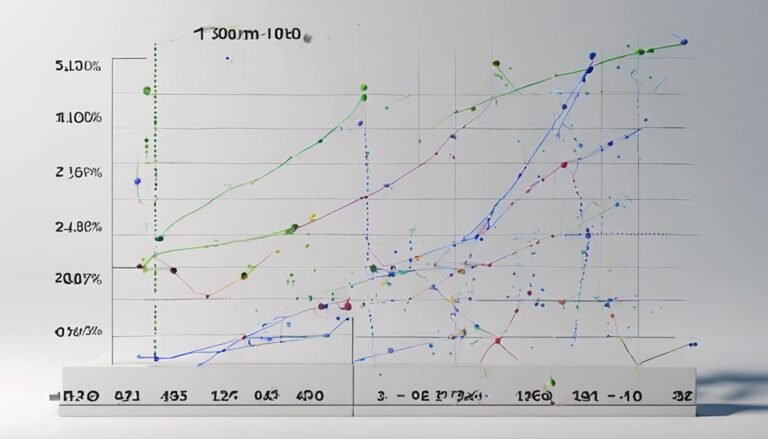FTA: Unveiling Trade Pacts for Economic Growth
Revealing the intricate web of Free Trade Agreements (FTAs) exposes their pivotal role in driving robust economic growth worldwide. With roots in colonial origins, modern FTAs emphasize mutual benefits, shaping international trade dynamics. They foster global integration, promote trade liberalization, spur economic growth, reshape industries, and drive innovation. Case studies like the KORUS FTA and CPTPP showcase how FTAs diversify exports, enhance market access, and stimulate economic growth. Despite concerns like job displacement and regulatory inadequacies, FTAs offer job creation potential, reduced trade barriers, and the promotion of economic growth. Further insights into their impacts and future prospects await.
Key Takeaways
- FTAs enhance economic growth through increased trade opportunities.
- Trade pacts drive economic development by reducing barriers to commerce.
- They facilitate market access, promoting cross-border business expansion.
- FTAs encourage innovation and industry evolution for sustained growth.
- These agreements foster global economic integration, benefiting participating nations.
Historical Evolution of FTAs
The historical evolution of Free Trade Agreements (FTAs) traces the progression of international trade agreements aimed at reducing import/export barriers and fostering cross-border economic cooperation.
FTAs have roots in colonial origins, where colonial powers imposed trade policies on their territories to benefit themselves. Over time, as countries gained independence, FTAs evolved to promote global integration and economic growth.
The shift towards global integration led to the establishment of modern FTAs, emphasizing mutual benefits and cooperation among nations. These agreements play an essential role in shaping international trade dynamics and fostering economic prosperity by creating a framework for trade that goes beyond national borders.
This evolution highlights the significance of FTAs in shaping the contemporary global economy.
Economic Impact of FTAs
Analyzing the economic repercussions of Free Trade Agreements (FTAs) reveals intricate interplays between international trade dynamics and national economic landscapes.
- Global Integration: FTAs foster closer economic ties between participating nations, leading to increased cross-border investments and collaboration.
- Trade Liberalization: By reducing tariffs and trade barriers, FTAs promote smoother trade flows, encouraging businesses to explore new markets and opportunities.
- Economic Growth: FTAs can spur economic growth by expanding market access, enhancing competitiveness, and attracting foreign direct investment.
These agreements have the potential to reshape industries, boost productivity, and drive innovation, ultimately contributing to the overall economic prosperity of nations involved.
Case Studies on Successful FTAs
Considering the intricate economic impacts of Free Trade Agreements (FTAs), it becomes imperative to dissect successful case studies that exemplify the tangible benefits of such trade pacts.
One notable case is the South Korea-United States Free Trade Agreement (KORUS FTA), which led to significant export diversification for both countries. By granting market access to various industries, including automotive and agriculture, the agreement bolstered trade volumes and enhanced competitiveness.
Another compelling example is the Comprehensive and Progressive Agreement for Trans-Pacific Partnership (CPTPP), which improved market access among member countries and stimulated economic growth through reduced tariffs.
These successful FTAs showcase how export diversification and increased market access can drive economic prosperity and foster mutually beneficial trade relationships.
Challenges and Criticisms of FTAs
What are the key challenges and criticisms associated with Free Trade Agreements in today's global economic landscape?
Free Trade Agreements (FTAs) have faced significant scrutiny due to their impact on job displacement and industry competition.
- Job Displacement: FTAs are often criticized for causing job losses in local industries as they struggle to compete with cheaper foreign labor markets.
- Industry Competition: FTAs can lead to increased competition for domestic industries, potentially forcing them to cut costs or relocate to remain competitive.
- Regulatory Concerns: Critics argue that FTAs may not provide adequate frameworks to promote fair competition and prevent exploitation of labor and resources.
These challenges highlight the complex trade-offs associated with FTAs and the need for careful consideration of their impact on various sectors of the economy.
Future Prospects for FTAs
The future prospects for Free Trade Agreements (FTAs) hold significant implications for global economic dynamics and inter-country relations. As countries continue to navigate the complexities of global integration, FTAs present opportunities for enhanced economic cooperation and growth.
One key aspect to take into account is job creation, as FTAs have the potential to stimulate employment through increased trade activities and market access. By fostering closer economic ties and reducing trade barriers, FTAs can pave the way for job opportunities in various sectors.
Additionally, FTAs can contribute to the development of industries and promote innovation, further fueling economic growth. Looking ahead, leveraging FTAs to prioritize job creation while promoting global integration will be vital for realizing the full potential of these trade agreements.
Conclusion
To sum up, the proliferation of Free Trade Agreements (FTAs) has played a pivotal role in fostering economic growth by facilitating cross-border trade and minimizing import/export barriers. Despite the challenges and criticisms associated with these agreements, the future prospects for FTAs remain promising.
By delving into the historical evolution, economic impacts, and case studies of successful FTAs, it becomes evident that these trade pacts serve as powerful instruments in shaping global economies.







